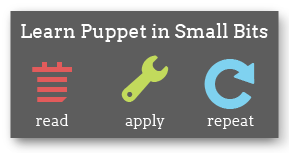puppet master Manual Page
NAME
puppet-master - The puppet master daemon
SYNOPSIS
The central puppet server. Functions as a certificate authority by default.
USAGE
puppet master [-D|--daemonize|--no-daemonize] [-d|--debug] [-h|--help] [-l|--logdest file|console|syslog] [-v|--verbose] [-V|--version] [--compile node-name]
DESCRIPTION
This command starts an instance of puppet master, running as a daemon and using Ruby's built-in Webrick webserver. Puppet master can also be managed by other application servers; when this is the case, this executable is not used.
OPTIONS
Note that any configuration parameter that's valid in the configuration file is also a valid long argument. For example, 'ssldir' is a valid configuration parameter, so you can specify '--ssldir directory' as an argument.
See the configuration file documentation at http://docs.puppetlabs.com/references/stable/configuration.html for the full list of acceptable parameters. A commented list of all configuration options can also be generated by running puppet master with '--genconfig'.
- --daemonize
Send the process into the background. This is the default.
- --no-daemonize
Do not send the process into the background.
- --debug
Enable full debugging.
- --help
Print this help message.
- --logdest
Where to send messages. Choose between syslog, the console, and a log file. Defaults to sending messages to syslog, or the console if debugging or verbosity is enabled.
- --verbose
Enable verbosity.
- --version
Print the puppet version number and exit.
- --compile
Compile a catalogue and output it in JSON from the puppet master. Uses facts contained in the $vardir/yaml/ directory to compile the catalog.
EXAMPLE
puppet master
DIAGNOSTICS
When running as a standalone daemon, puppet master accepts the following signals:
- SIGHUP
- Restart the puppet master server.
- SIGINT and SIGTERM
- Shut down the puppet master server.
AUTHOR
Luke Kanies
COPYRIGHT
Copyright (c) 2011 Puppet Labs, LLC Licensed under the Apache 2.0 License

